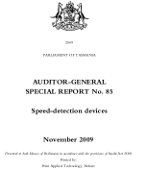11/20/2009
Australian Audit Report: Safety Not Sole Concern in Speed Camera DeploymentAuditor general of Tasmania, Australia suggests concerns other than safety drive choice of speed camera deployment locations and times.

A report by the Auditor General of Tasmania, Australia released yesterday called into question whether speed cameras were being deployed based on revenue concerns. A team of investigators interviewed police officials, examined documents and other records in order to analyze the state's photo ticketing program over the course of eight months. The final audit questioned why safety concerns did not appear to guide camera placement.
"We tested to see whether deployment of [photo radar] resources to the various speed zones was a reasonable reflection of the proportion of accidents occurring within them," the report explained. "Figure 8 appears to show a low correlation between the level of enforcement and serious and fatal crashes on a speed zone basis. Department of Police and Emergency Management has directed a disproportionate percentage of its speed camera enforcement resources towards the 40 to 60 km/h zones, despite a higher percentage of serious and fatal road crashes occurring in the 100 and 110 km/h zones."
The report also found that most crashes happen in the afternoon, but the speed cameras tended to be deployed in the morning. The auditor found the disparity between the times when accidents happen most and when the cameras were deployed to have been "excessive." The report found that speed cameras were idle an average of 22 percent of the time because of "operator leave, faulty equipment, or equipment transport delays." When photographs taken did not result in citations, the cause 9 percent of the time was "operator error" and "equipment failure" 29 percent of the time.
The average driver in Tasmania passed by a speed camera at least twice a month, placing Tasmania second only to Victoria in issuing the most citations per capita. Despite the heavy ticketing, the report found no credible evidence of a reduction in speeding as a result of the cameras. To the contrary, since 2003, the number of speeding tickets issued per thousand vehicles monitored has increased, not decreased.
Opposition Police Spokesman Rene Hidding called the report evidence of "dollar driven government" in a statement.
"The Tasmanian driving public have been telling us for years that they feel speed cameras are revenue raisers because of their locations," Hidding said. "The auditor-general appears to agree with these concerns."
To further increase the number of citations, the audit report recommended deploying more fixed speed cameras because they "represent good value for money in locations with high-volume traffic." It recommended that traffic police issue fewer warnings to drivers in 2009. The auditor also recommended realigning camera deployments with safety concerns.
A copy of the report is available in a 1.1mb PDF file at the source link below.


